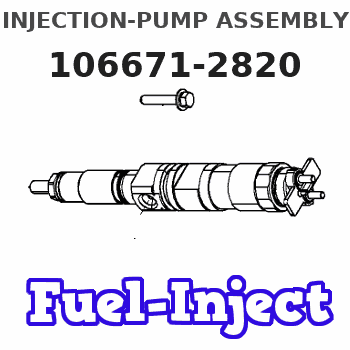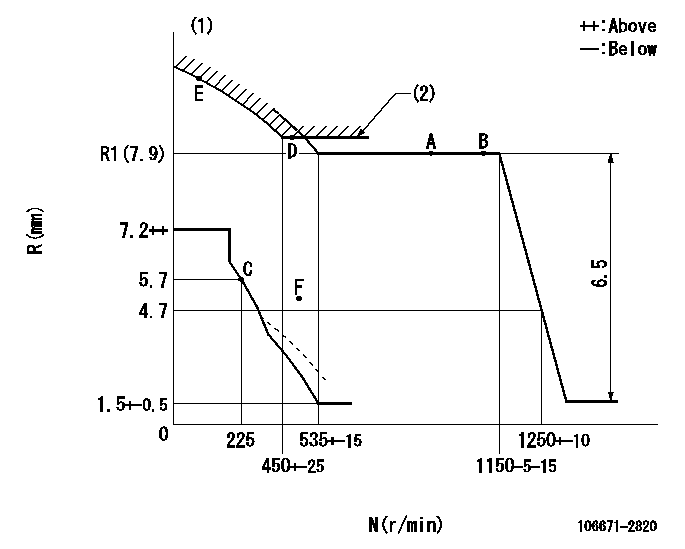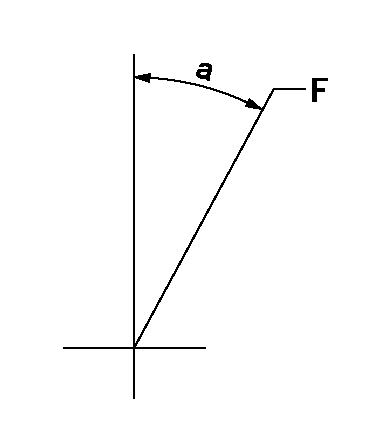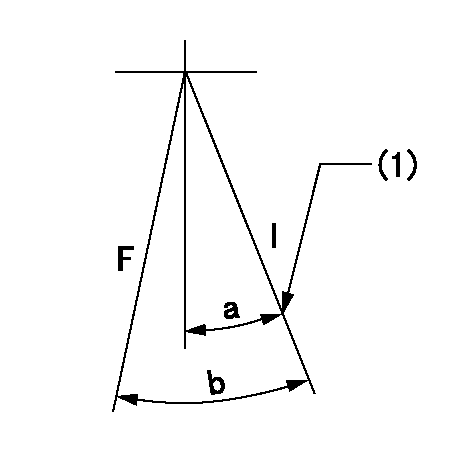Information injection-pump assembly
ZEXEL
106671-2820
1066712820
MITSUBISHI
ME056397
me056397

Rating:
Cross reference number
ZEXEL
106671-2820
1066712820
MITSUBISHI
ME056397
me056397
Zexel num
Bosch num
Firm num
Name
Calibration Data:
Adjustment conditions
Test oil
1404 Test oil ISO4113 or {SAEJ967d}
1404 Test oil ISO4113 or {SAEJ967d}
Test oil temperature
degC
40
40
45
Nozzle and nozzle holder
105780-8140
Bosch type code
EF8511/9A
Nozzle
105780-0000
Bosch type code
DN12SD12T
Nozzle holder
105780-2080
Bosch type code
EF8511/9
Opening pressure
MPa
17.2
Opening pressure
kgf/cm2
175
Injection pipe
Outer diameter - inner diameter - length (mm) mm 8-3-600
Outer diameter - inner diameter - length (mm) mm 8-3-600
Overflow valve
131424-4620
Overflow valve opening pressure
kPa
255
221
289
Overflow valve opening pressure
kgf/cm2
2.6
2.25
2.95
Tester oil delivery pressure
kPa
157
157
157
Tester oil delivery pressure
kgf/cm2
1.6
1.6
1.6
Direction of rotation (viewed from drive side)
Right R
Right R
Injection timing adjustment
Direction of rotation (viewed from drive side)
Right R
Right R
Injection order
1-5-3-6-
2-4
Pre-stroke
mm
4.8
4.75
4.85
Beginning of injection position
Governor side NO.1
Governor side NO.1
Difference between angles 1
Cal 1-5 deg. 60 59.5 60.5
Cal 1-5 deg. 60 59.5 60.5
Difference between angles 2
Cal 1-3 deg. 120 119.5 120.5
Cal 1-3 deg. 120 119.5 120.5
Difference between angles 3
Cal 1-6 deg. 180 179.5 180.5
Cal 1-6 deg. 180 179.5 180.5
Difference between angles 4
Cyl.1-2 deg. 240 239.5 240.5
Cyl.1-2 deg. 240 239.5 240.5
Difference between angles 5
Cal 1-4 deg. 300 299.5 300.5
Cal 1-4 deg. 300 299.5 300.5
Injection quantity adjustment
Adjusting point
-
Rack position
7.9
Pump speed
r/min
700
700
700
Each cylinder's injection qty
mm3/st.
104
101.4
106.6
Basic
*
Fixing the rack
*
Standard for adjustment of the maximum variation between cylinders
*
Injection quantity adjustment_02
Adjusting point
F
Rack position
5+-0.5
Pump speed
r/min
500
500
500
Each cylinder's injection qty
mm3/st.
16.5
14
19
Fixing the rack
*
Standard for adjustment of the maximum variation between cylinders
*
Injection quantity adjustment_03
Adjusting point
A
Rack position
R1(7.9)
Pump speed
r/min
700
700
700
Average injection quantity
mm3/st.
104
103
105
Basic
*
Fixing the lever
*
Injection quantity adjustment_04
Adjusting point
B
Rack position
R1(7.9)
Pump speed
r/min
1100
1100
1100
Average injection quantity
mm3/st.
118
114
122
Difference in delivery
mm3/st.
8
8
8
Fixing the lever
*
Injection quantity adjustment_05
Adjusting point
C
Rack position
5.7+-0.5
Pump speed
r/min
225
225
225
Each cylinder's injection qty
mm3/st.
16.5
14
19
Fixing the rack
*
Remarks
(check)
(check)
Injection quantity adjustment_06
Adjusting point
E
Rack position
-
Pump speed
r/min
100
100
100
Average injection quantity
mm3/st.
150
130
170
Fixing the lever
*
Timer adjustment
Pump speed
r/min
950
Advance angle
deg.
0.5
Timer adjustment_02
Pump speed
r/min
1050
Advance angle
deg.
2.2
1.7
2.7
Timer adjustment_03
Pump speed
r/min
1150
Advance angle
deg.
5.5
5
6
Remarks
Finish
Finish
Test data Ex:
Governor adjustment

N:Pump speed
R:Rack position (mm)
(1)Beginning of damper spring operation: DL
(2)Excess fuel setting for starting: SXL
----------
DL=4.5-0.2mm SXL=R1(7.9)+0.2mm
----------
----------
DL=4.5-0.2mm SXL=R1(7.9)+0.2mm
----------
Speed control lever angle

F:Full speed
----------
----------
a=27deg+-5deg
----------
----------
a=27deg+-5deg
0000000901

F:Full load
I:Idle
(1)Stopper bolt setting
----------
----------
a=21deg+-5deg b=23deg+-3deg
----------
----------
a=21deg+-5deg b=23deg+-3deg
Stop lever angle

N:Pump normal
S:Stop the pump.
(1)Stopper bolt setting
(2)Rack position = aa
(3)Rack position bb
(4)Free (at delivery)
----------
aa=4.1-0.5mm bb=13.1mm
----------
a=27deg+-5deg b=(56deg) c=0deg+7deg-5deg
----------
aa=4.1-0.5mm bb=13.1mm
----------
a=27deg+-5deg b=(56deg) c=0deg+7deg-5deg
0000001501 MICRO SWITCH
Adjustment of the micro-switch
Adjust the bolt to obtain the following lever position when the micro-switch is ON.
(1)Speed N1
(2)Rack position Ra
----------
N1=325+-0.5r/min Ra=5.4mm
----------
----------
N1=325+-0.5r/min Ra=5.4mm
----------
Timing setting

(1)Pump vertical direction
(2)Coupling's key groove position at No 1 cylinder's beginning of injection
(3)-
(4)-
----------
----------
a=(7deg)
----------
----------
a=(7deg)
Information:
Rating Definitions
The Caterpillar marine propulsion engine rating definitions are:* A - Continuous Duty-For heavy duty use with little load cycling (throttle operation up to 100 percent of total time) in oceangoing displacement hulls such as freighters, tugboats and bottom-drag trawlers, and deep river towboats. Expected usage is 4000 hours per year or more.* B - Medium Duty-For use with full throttle operation up to 80 percent of total operation time with the balance of time below rated rpm in midwater trawlers, purse seiners, crew and supply boats, ferry boats with trips longer than one hour, and towboats in rivers where locks, sandbars, curves or traffic dictate frequent slowing. Expected usage is 4000 hours per year, average, is typical, but could be higher.* C - Intermittent Duty-For use with full throttle operation up to 50 percent of total operation time with the balance of time below rated rpm in yachts with displacement hulls, as well as ferries with trips less than one hour, fish boats moving at higher speeds out and back (e.g., lobster, crayfish and tuna), and short trip coastal freighters where engine load and speed are cyclical. Expected usage of up to 3000 hours per year, average, is typical.* D - Patrol Craft-For use in patrol, customs, police and some fire boats. Also for bow/stern thrusters. Full throttle operation up to ten percent of total operation time with balance of time below rated rpm. Expected usage is less than 2000 hours per year.* E - High Performance-For use in pleasure craft with planing hulls, as well as for pilot, harbor patrol and harbor master boats with full throttle operation up to five percent of total operation time with balance of time below rated rpm. Expected usage is 200 to 300 hours per year. Some fish boats operate on duty cycles where D or E engine ratings apply.Time at full throttle is the cumulative time the engine is operated at full throttle load and speed during a work cycle, duty cycle, or voyage.These rating definitions dictate the selection of a rating for an application based on a load profile determined by time at various throttle settings or engine speeds. In general, an application requiring less time at full throttle, or lower engine rpm at reduced throttle operation, can utilize a higher rating.Application Guidelines
In selecting a rating for a specific application, the most important consideration is time spent at full throttle. Additionally, these rating definitions identify percent of time at full throttle and corresponding times below rated rpm. This rpm reduction lowers kW (horsepower) requirements as propeller demand follows a cubic speed/power curve.For example, an engine operating at 90 percent of rated speed would be loaded by a typical propeller to about 73 percent of rated power. Operating at recommended reduced speed controls the engine load at or below the continuous power level.As a general guideline, typical operating parameters for each rating level are summarized in the following chart. For more information, refer to your Caterpillar dealer and EDS
The Caterpillar marine propulsion engine rating definitions are:* A - Continuous Duty-For heavy duty use with little load cycling (throttle operation up to 100 percent of total time) in oceangoing displacement hulls such as freighters, tugboats and bottom-drag trawlers, and deep river towboats. Expected usage is 4000 hours per year or more.* B - Medium Duty-For use with full throttle operation up to 80 percent of total operation time with the balance of time below rated rpm in midwater trawlers, purse seiners, crew and supply boats, ferry boats with trips longer than one hour, and towboats in rivers where locks, sandbars, curves or traffic dictate frequent slowing. Expected usage is 4000 hours per year, average, is typical, but could be higher.* C - Intermittent Duty-For use with full throttle operation up to 50 percent of total operation time with the balance of time below rated rpm in yachts with displacement hulls, as well as ferries with trips less than one hour, fish boats moving at higher speeds out and back (e.g., lobster, crayfish and tuna), and short trip coastal freighters where engine load and speed are cyclical. Expected usage of up to 3000 hours per year, average, is typical.* D - Patrol Craft-For use in patrol, customs, police and some fire boats. Also for bow/stern thrusters. Full throttle operation up to ten percent of total operation time with balance of time below rated rpm. Expected usage is less than 2000 hours per year.* E - High Performance-For use in pleasure craft with planing hulls, as well as for pilot, harbor patrol and harbor master boats with full throttle operation up to five percent of total operation time with balance of time below rated rpm. Expected usage is 200 to 300 hours per year. Some fish boats operate on duty cycles where D or E engine ratings apply.Time at full throttle is the cumulative time the engine is operated at full throttle load and speed during a work cycle, duty cycle, or voyage.These rating definitions dictate the selection of a rating for an application based on a load profile determined by time at various throttle settings or engine speeds. In general, an application requiring less time at full throttle, or lower engine rpm at reduced throttle operation, can utilize a higher rating.Application Guidelines
In selecting a rating for a specific application, the most important consideration is time spent at full throttle. Additionally, these rating definitions identify percent of time at full throttle and corresponding times below rated rpm. This rpm reduction lowers kW (horsepower) requirements as propeller demand follows a cubic speed/power curve.For example, an engine operating at 90 percent of rated speed would be loaded by a typical propeller to about 73 percent of rated power. Operating at recommended reduced speed controls the engine load at or below the continuous power level.As a general guideline, typical operating parameters for each rating level are summarized in the following chart. For more information, refer to your Caterpillar dealer and EDS